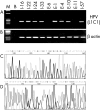Detection of human papillomavirus DNA in pterygia from different geographical regions
- PMID: 12812887
- PMCID: PMC1771763
- DOI: 10.1136/bjo.87.7.864
Detection of human papillomavirus DNA in pterygia from different geographical regions
Abstract
Background/aims: The aetiology and pathogenesis of pterygia remain unclear and the involvement of human papillomavirus (HPV) is controversial. 41 pterygia from two geographic locations were evaluated for the presence of HPV DNA.
Methods: 41 pterygium biopsies (17 from Italy and 24 from Ecuador) were analysed using the L1C1 and PU-1ML primer sets by polymerase chain reaction (PCR) and DNA sequence analysis.
Results: 22 of the 41 pterygia (54%) were positive for HPV, including all 17 Italian cases and 5/24 (21%) Ecuadorean cases. DNA sequencing of the 22 positive cases showed that 11 were HPV type 52, four were type 54, five were candHPV90, and two of unknown genotype.
Conclusions: The major differences in the frequency of HPV in geographically distant populations might suggest a possible explanation for the vast differences in the reported detection rates. Three subtypes of HPV were found in this sample of pterygia. None the less, these results suggest that HPV may have a pathogenic role in pterygium.
Figures

Comment in
-
Does human papillomavirus cause pterygium?Br J Ophthalmol. 2003 Jul;87(7):806-8. doi: 10.1136/bjo.87.7.806. Br J Ophthalmol. 2003. PMID: 12812871 Free PMC article. No abstract available.
Similar articles
-
Human papillomavirus and pterygium. Is the virus a risk factor?Br J Ophthalmol. 2007 Aug;91(8):1016-8. doi: 10.1136/bjo.2006.108829. Epub 2006 Dec 19. Br J Ophthalmol. 2007. PMID: 17179167 Free PMC article.
-
Prevalence and viral load of oncogenic human papillomavirus (HPV) in pterygia in multi-ethnic patients in the Malay Peninsula.Acta Ophthalmol. 2014 Nov;92(7):e569-79. doi: 10.1111/aos.12427. Epub 2014 Jul 18. Acta Ophthalmol. 2014. PMID: 25043991
-
Human papillomavirus in pterygium.Br J Ophthalmol. 2001 Jul;85(7):782-4. doi: 10.1136/bjo.85.7.782. Br J Ophthalmol. 2001. PMID: 11423447 Free PMC article.
-
Detection of human papillomavirus in esophageal and gastroesophageal junction tumors: A retrospective study by real-time polymerase chain reaction in an instutional experience from Turkey and review of literature.Pathol Res Pract. 2016 Feb;212(2):77-82. doi: 10.1016/j.prp.2015.10.007. Epub 2015 Oct 23. Pathol Res Pract. 2016. PMID: 26608416 Review.
-
Association of human papilloma virus with pterygia and ocular-surface squamous neoplasia.Eye (Lond). 2012 Feb;26(2):202-11. doi: 10.1038/eye.2011.312. Epub 2011 Dec 2. Eye (Lond). 2012. PMID: 22134594 Free PMC article. Review.
Cited by
-
EFFECT OF SUN EXPOSURE DURATION ON CYCLOOXYGENASE-2 EXPRESSION IN THE CONJUNCTIVA.Acta Clin Croat. 2019 Dec;58(4):639-646. doi: 10.20471/acc.2019.58.04.11. Acta Clin Croat. 2019. PMID: 32595249 Free PMC article.
-
Human papillomavirus infection and ocular surface disease (Review).Int J Oncol. 2019 May;54(5):1503-1510. doi: 10.3892/ijo.2019.4755. Epub 2019 Mar 19. Int J Oncol. 2019. PMID: 30896784 Free PMC article. Review.
-
Human papillomavirus and pterygium. Is the virus a risk factor?Br J Ophthalmol. 2007 Aug;91(8):1016-8. doi: 10.1136/bjo.2006.108829. Epub 2006 Dec 19. Br J Ophthalmol. 2007. PMID: 17179167 Free PMC article.
-
Viral involvement in the pathogenesis and clinical features of ophthalmic pterygium (Review).Int J Mol Med. 2013 Sep;32(3):539-43. doi: 10.3892/ijmm.2013.1438. Epub 2013 Jul 12. Int J Mol Med. 2013. PMID: 23856952 Free PMC article. Review.
-
The role of HPV in the etiopathogenesis of pterygium and the relationship with recurrence.Int Ophthalmol. 2023 Oct;43(10):3793-3801. doi: 10.1007/s10792-023-02791-2. Epub 2023 Jul 9. Int Ophthalmol. 2023. PMID: 37422852
References
-
- De Villiers EM. Papillomavirus and HPV typing. Clin Dermatol 1997;15:199–206. - PubMed
-
- Zur Hausen H. Papillomavirus infections–a major cause of human cancers. Biochim Biophys Acta 1996;1288:F55–78. - PubMed
-
- Melbye M, Frisch M. The role of human papillomaviruses in anogenital cancers. Sem Cancer Biol 1998;8:307–13. - PubMed
-
- Friis S, Kjaer SK, Frisch M, et al. Cervical intraepithelial neoplasia, anogenital cancer, and other cancer types in women after hospitalization for condylomata acuminata. J Infect Dis 1997;175:743–8. - PubMed
-
- Schiffman MH, Bauer HM, Hoover RN, et al. Epidemiologic evidence showing that human papillomavirus infection causes most cervical intraepithelial neoplasia. J Natl Cancer Inst 1993;85:958–64. - PubMed
Publication types
MeSH terms
Substances
LinkOut - more resources
Full Text Sources
